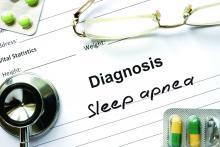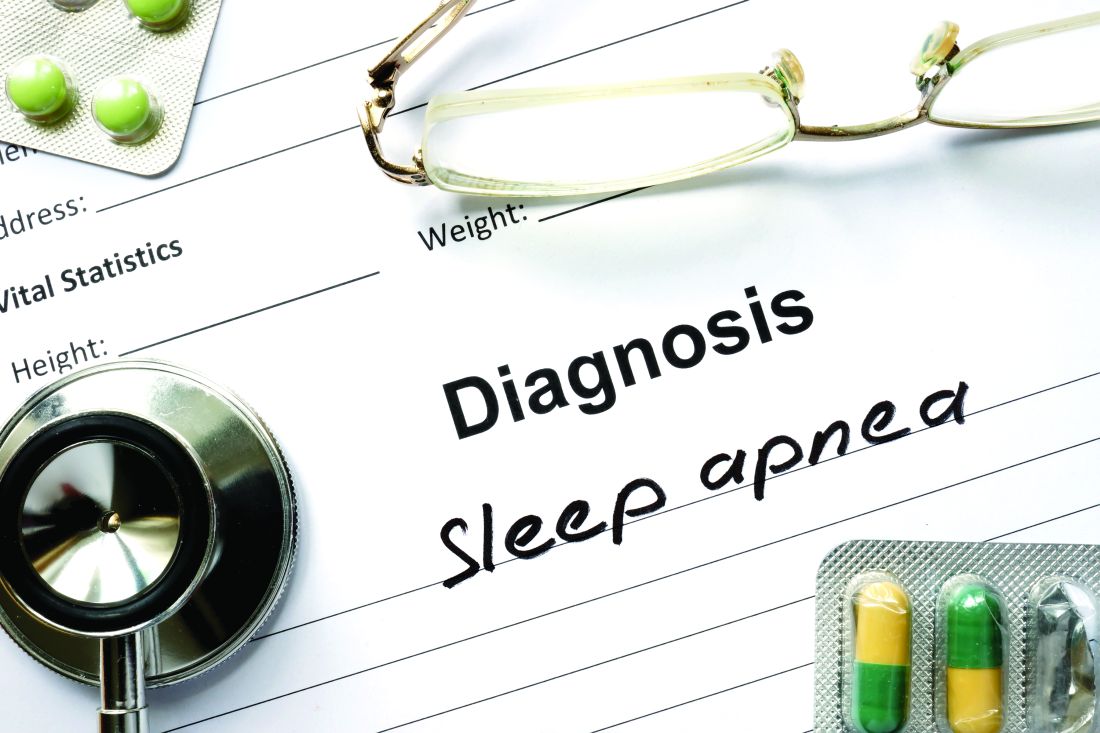User login
The oxidative stress biomarker 8-isoprostane (8-IsoP) predicted obstructive sleep apnea (OSA) and disease severity in children better than the fractional concentration of exhaled nitric oxide (FENO), according to results published in Sleep Medicine.
In an analysis of 46 patients with sleep-disordered breathing and 20 controls, 8-IsoP values were also correlated with apnea hypopnea index (AHI) (r, 0.40; P = .003) and oxygen saturation, also known as SaO2, (r, –0.50; P = .001), reported Dr. Mario Berreto of the Pediatric Unit at Sant’Andrea Hospital in Rome and his coauthors.
The investigators studied 66 children aged 4.5-15.1 years, of whom 46 had sleep-disordered breathing (SDB) and were enrolled in the hospital’s Pediatric Sleep Center. The 20 healthy controls had no history of sleep problems, including snoring, apneas, and restless sleep. Exclusion criteria included acute respiratory infections in the 4 weeks preceding the study, chronic respiratory comorbidities, and therapy with corticosteroids or other anti-inflammatory drugs for at least 3 weeks.
Patients with SDB had a medical examination followed by overnight standard polysomnography (PSG), and EBC 8-IsoP and FENO measurements were collected the next morning upon waking. The SDB group also had spirometry and skin prick testing for common allergens. The children in the control group had the same tests and measurements done, except for PSG, Dr. Berreto and his colleagues wrote.
Central, obstructive, and mixed apnea events were counted according to American Academy of Sleep Medicine (AASM) criteria. AHI was defined as the average number of apnea and hypopnea events per hour of sleep. OSA was diagnosed with an AHI of one episode per hour and confirmed by the presence of SDB symptoms with AHI of one episode per hour.
Children with snoring and an AHI of less than one episode per hour were diagnosed with primary snoring (PS). Patients with an AHI greater than one episode per hour and less than five episodes per hour were diagnosed with mild OSA. Children with an AHI of greater than five episodes per hour were diagnosed with moderate to severe OSA, the authors said.
While 8-IsoP concentrations correlated with OSA severity for AHI and SaO2, FENO did not, Dr. Berreto and colleagues reported.
The difference in 8-IsoP concentrations for children with SDB and controls (mean, 39.6; P = .006) was increased when adjusted using multiple linear regression (mean, 43.2; P = .007), and the difference was even more pronounced when adjusted for all potential confounding variables (mean, 53.1; P = .008). The difference in FENO levels between SDB patients and controls was not statistically significant (mean, 1.67; P = .358) and did not change significantly when adjusted for confounding variables.
High area under the curve values were observed for 8-IsoP as a predictor of OSA (.839; 95% confidence interval, .744-.933, P = .000). The sensitivity and specificity of cutoff values of 8-IsoP concentrations above the 50th percentile were 76.5% and 78.1%, respectively.
“[It] seems that biomarkers of oxidative stress reflect OSA severity in children more closely than biomarkers of atopic-eosinophilic airway inflammation,” the authors concluded.
No disclosures or conflicts of interest were reported.
SOURCE: Barreto M et al. Sleep Medicine. 2018. doi: 10.1016/j.sleep.2018.01.011.
The oxidative stress biomarker 8-isoprostane (8-IsoP) predicted obstructive sleep apnea (OSA) and disease severity in children better than the fractional concentration of exhaled nitric oxide (FENO), according to results published in Sleep Medicine.
In an analysis of 46 patients with sleep-disordered breathing and 20 controls, 8-IsoP values were also correlated with apnea hypopnea index (AHI) (r, 0.40; P = .003) and oxygen saturation, also known as SaO2, (r, –0.50; P = .001), reported Dr. Mario Berreto of the Pediatric Unit at Sant’Andrea Hospital in Rome and his coauthors.
The investigators studied 66 children aged 4.5-15.1 years, of whom 46 had sleep-disordered breathing (SDB) and were enrolled in the hospital’s Pediatric Sleep Center. The 20 healthy controls had no history of sleep problems, including snoring, apneas, and restless sleep. Exclusion criteria included acute respiratory infections in the 4 weeks preceding the study, chronic respiratory comorbidities, and therapy with corticosteroids or other anti-inflammatory drugs for at least 3 weeks.
Patients with SDB had a medical examination followed by overnight standard polysomnography (PSG), and EBC 8-IsoP and FENO measurements were collected the next morning upon waking. The SDB group also had spirometry and skin prick testing for common allergens. The children in the control group had the same tests and measurements done, except for PSG, Dr. Berreto and his colleagues wrote.
Central, obstructive, and mixed apnea events were counted according to American Academy of Sleep Medicine (AASM) criteria. AHI was defined as the average number of apnea and hypopnea events per hour of sleep. OSA was diagnosed with an AHI of one episode per hour and confirmed by the presence of SDB symptoms with AHI of one episode per hour.
Children with snoring and an AHI of less than one episode per hour were diagnosed with primary snoring (PS). Patients with an AHI greater than one episode per hour and less than five episodes per hour were diagnosed with mild OSA. Children with an AHI of greater than five episodes per hour were diagnosed with moderate to severe OSA, the authors said.
While 8-IsoP concentrations correlated with OSA severity for AHI and SaO2, FENO did not, Dr. Berreto and colleagues reported.
The difference in 8-IsoP concentrations for children with SDB and controls (mean, 39.6; P = .006) was increased when adjusted using multiple linear regression (mean, 43.2; P = .007), and the difference was even more pronounced when adjusted for all potential confounding variables (mean, 53.1; P = .008). The difference in FENO levels between SDB patients and controls was not statistically significant (mean, 1.67; P = .358) and did not change significantly when adjusted for confounding variables.
High area under the curve values were observed for 8-IsoP as a predictor of OSA (.839; 95% confidence interval, .744-.933, P = .000). The sensitivity and specificity of cutoff values of 8-IsoP concentrations above the 50th percentile were 76.5% and 78.1%, respectively.
“[It] seems that biomarkers of oxidative stress reflect OSA severity in children more closely than biomarkers of atopic-eosinophilic airway inflammation,” the authors concluded.
No disclosures or conflicts of interest were reported.
SOURCE: Barreto M et al. Sleep Medicine. 2018. doi: 10.1016/j.sleep.2018.01.011.
The oxidative stress biomarker 8-isoprostane (8-IsoP) predicted obstructive sleep apnea (OSA) and disease severity in children better than the fractional concentration of exhaled nitric oxide (FENO), according to results published in Sleep Medicine.
In an analysis of 46 patients with sleep-disordered breathing and 20 controls, 8-IsoP values were also correlated with apnea hypopnea index (AHI) (r, 0.40; P = .003) and oxygen saturation, also known as SaO2, (r, –0.50; P = .001), reported Dr. Mario Berreto of the Pediatric Unit at Sant’Andrea Hospital in Rome and his coauthors.
The investigators studied 66 children aged 4.5-15.1 years, of whom 46 had sleep-disordered breathing (SDB) and were enrolled in the hospital’s Pediatric Sleep Center. The 20 healthy controls had no history of sleep problems, including snoring, apneas, and restless sleep. Exclusion criteria included acute respiratory infections in the 4 weeks preceding the study, chronic respiratory comorbidities, and therapy with corticosteroids or other anti-inflammatory drugs for at least 3 weeks.
Patients with SDB had a medical examination followed by overnight standard polysomnography (PSG), and EBC 8-IsoP and FENO measurements were collected the next morning upon waking. The SDB group also had spirometry and skin prick testing for common allergens. The children in the control group had the same tests and measurements done, except for PSG, Dr. Berreto and his colleagues wrote.
Central, obstructive, and mixed apnea events were counted according to American Academy of Sleep Medicine (AASM) criteria. AHI was defined as the average number of apnea and hypopnea events per hour of sleep. OSA was diagnosed with an AHI of one episode per hour and confirmed by the presence of SDB symptoms with AHI of one episode per hour.
Children with snoring and an AHI of less than one episode per hour were diagnosed with primary snoring (PS). Patients with an AHI greater than one episode per hour and less than five episodes per hour were diagnosed with mild OSA. Children with an AHI of greater than five episodes per hour were diagnosed with moderate to severe OSA, the authors said.
While 8-IsoP concentrations correlated with OSA severity for AHI and SaO2, FENO did not, Dr. Berreto and colleagues reported.
The difference in 8-IsoP concentrations for children with SDB and controls (mean, 39.6; P = .006) was increased when adjusted using multiple linear regression (mean, 43.2; P = .007), and the difference was even more pronounced when adjusted for all potential confounding variables (mean, 53.1; P = .008). The difference in FENO levels between SDB patients and controls was not statistically significant (mean, 1.67; P = .358) and did not change significantly when adjusted for confounding variables.
High area under the curve values were observed for 8-IsoP as a predictor of OSA (.839; 95% confidence interval, .744-.933, P = .000). The sensitivity and specificity of cutoff values of 8-IsoP concentrations above the 50th percentile were 76.5% and 78.1%, respectively.
“[It] seems that biomarkers of oxidative stress reflect OSA severity in children more closely than biomarkers of atopic-eosinophilic airway inflammation,” the authors concluded.
No disclosures or conflicts of interest were reported.
SOURCE: Barreto M et al. Sleep Medicine. 2018. doi: 10.1016/j.sleep.2018.01.011.
FROM SLEEP MEDICINE
Key clinical point: The biomarker 8-isoprostane predicted OSA and correlated with disease severity in children.
Major finding: Children with OSA had higher levels of 8-IsoP than patients with primary snoring (PS) and controls; 8-IsoP values were also correlated with apnea hypopnea index (r, 0.40; P = .003).
Study details: A single-center, cross-sectional observational study of 46 children with sleep-disordered breathing and 20 healthy controls.
Disclosures: No disclosures or conflicts of interest were reported.
Source: Barreto M et al. Sleep Medicine. 2018. doi: https://doi.org/10.1016/j.sleep.2018.01.011.

